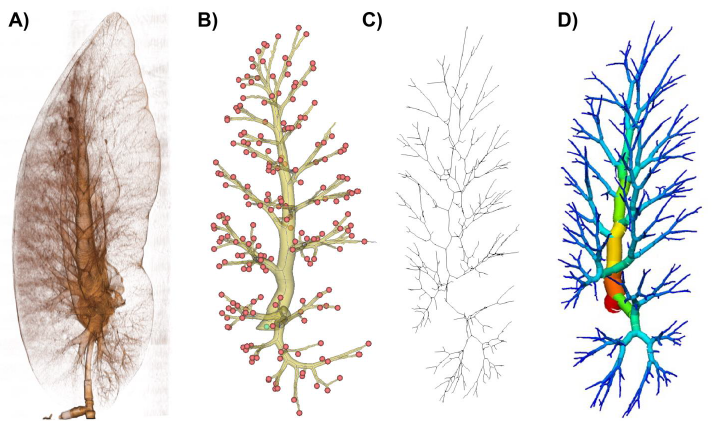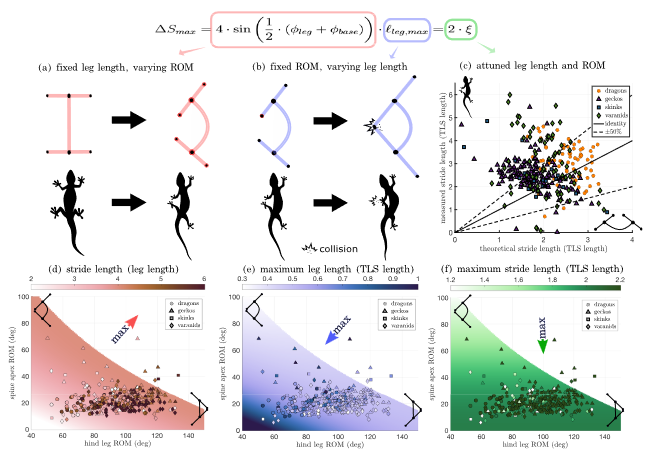
Whale lung geometry and diving
RL Cieri, MH Tawhai, M Piscitelli-Doshkov, AW Vogl, RE Shadwick. Geometric analysis of airway trees shows that lung anatomy evolved to enable explosive ventilation and prevent barotrauma in cetaceans. BioRXiv Preprint. 2024. DOI:10.1101/2024.10.16.618729.

Coordinating the Spine and Limbs in Lizards
Coordinating limbs and spine: (Pareto-) optimal locomotion in theory, in vivo, and in robots, 2024. npj Robotics. DOI:10.1038/s44182-024-00011-2.

How do Muscle Fibres Scale in Reptiles?
Cieri RL, Dick TJM, Morris JS, Clemente CJ. Scaling of fibre area and fibre glycogen concetration in the hindlimb musculature of monitor lizards: implications for locomotor performance with increasing body size. The Journal of Experimental Biology. 2022. DOI:10.1424/keb.243380.

Modular Ventilation in Snakes
Capano JG, Boback SM, Weller HI, Cieri RL, Zwemer CF, Brainerd EL. Modular lung ventilation in Boa constrictor. The Journal of Expermental Biology. 2022. DOI:10.1242/jeb.243119.

Virtual Reality in Comparative Anatomy
Cieri RL, Turney M, ... Farmer CG. Virtual and augmented reality: new tools
for visualizing, analyzing, and communicating complex morphology. The Journal of Morphology. 2021. DOI:10.1002/jmor.21421.

The scaling of Ground Reaction Forces in Monitor Lizards
Cieri RL, Irwin RJ, Rumsey D, Dick TJM, and Clemente CJ. Ground reaction forces in monitor lizards
and the scaling of locomotion in sprawling tetrapods. Biology Letters. 2021. DOI:10.1098/rsbl.2020.0612.

Muscle Allometry in Varanid Limbs
Cieri RL, Dick TJM, and Clemente CJ. Monitoring muscle over three orders of magnitude: widespread
positive allometry among locomotor and body support musculature in the pectoral girdle of varanid
lizards (Varanidae). The Journal of Anatomy. 2020. DOI:10.1111/joa.13273.

The origin of costal ventilation
Cieri RL, Hatch SH, Capano JG, and Brainerd EL. Locomotor rib kinematics in two species of lizards
and a new hypothesis for the evolution of aspiration breathing in amniotes. Scientific Reports. 2020. 10.1038/s41598-020-64140-y.

Net Unidirectional Airflow in Monitor Lungs (Varanus exanthematicus)
Cieri RL and Farmer CG. Computational Fluid Dynamics Reveals a Unique Net Unidirectional Pattern of Pulmonary Airflow in the Savannah Monitor Lizard (Varanus exanthematicus). The Anatomical Record. 2019. DOI:10.1002/ar.242939.

Breathing with floating ribs
Cieri RL, Moritz S, Capano JG, Brainerd EL. Breathing with floating ribs: XROMM analysis of lung ventilation in savannah monitor lizards. J Exp Biol [Internet]. 2018;221(22):jeb.189449. Available from: http://jeb.biologists.org/lookup/doi/10.1242/jeb.189449

Axial anatomy of monitor lizards
Cieri, RL (2018). The axial anatomy of monitor lizards (Varanidae). J. Anat. 233, 636–643.

Review: Pulmonary smooth muscle in vertebrates
Cieri, RL (2019). Pulmonary smooth muscle in vertebrates: A comparative review of structure and function. Integrative and Comparative Biology, 59, 10–28.

XROMM analysis of ventilation in tegus
Cieri, RL, Moritz, S, Capano, JG, & Brainerd, EL (2018). Breathing with floating ribs: XROMM analysis of lung ventilation in savannah monitor lizards. The Journal of Experimental Biology, 221, jeb.189449.

Review: Unidirectional Pulmonary Airflow
Cieri, RL, & Farmer, CG (2016). Unidirectional pulmonary airflow in vertebrates: a review of structure, function, and evolution. Journal of Comparative Physiology B, 186, 541–552.

Unidirectional airflow in green igugnas
Cieri, RL, Craven, BA, Schachner, ER & Farmer, CG (2014). New insight into the evolution of the vertebrate respiratory system and the discovery of unidirectional airflow in iguana lungs. Proceedings of the National Academy of Sciences of the United States of America, 111, 17218–17223..

Unidirectional airflow in monitors
Schachner, ER, Cieri, RL, Butler, JP & Farmer, CG (2013). Unidirectional pulmonary airflow patterns in the savannah monitor lizard. Nature, 506, 367–370.

Human self domestication in the fossil record
Cieri, RL, Churchill, SE, Franciscus, RG, Tan, J & Hare, B (2014). Craniofacial Feminization, Social Tolerance, and the Origins of Behavioral Modernity. Current Anthropology, 55, 419–443.




























